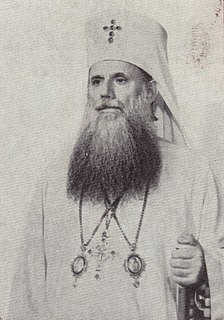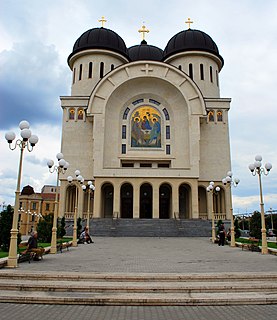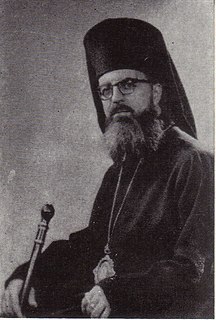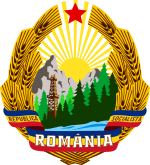Mircea Dinescu is a Romanian poet, journalist, and editor.

The Romanian Orthodox Church, or Patriarchate of Romania, is an autocephalous Eastern Orthodox church in full communion with other Eastern Orthodox Christian churches, and one of the nine patriarchates in the Eastern Orthodox Church. Since 1925, the church's Primate bears the title of Patriarch. Its jurisdiction covers the territories of Romania and Moldova, with additional dioceses for Romanians living in nearby Serbia and Hungary, as well as for diaspora communities in Central and Western Europe, North America and Oceania. It is the only autocephalous church within Eastern Orthodoxy to have a Romance language for liturgical use.

Justinian Marina was a Romanian Orthodox prelate. He was the third patriarch of the Romanian Orthodox Church, serving between 1948 and 1977.
The Antim Monastery is located in Bucharest, Romania on Mitropolit Antim Ivireanu Street, no. 29. It was built between 1713 and 1715 by Saint Antim Ivireanu, at that time a Metropolitan Bishop of Wallachia. The buildings were restored by Patriarch Justinian Marina in the 1960s. As of 2005, there are 7 monks living in the Monastery. The monastery also hosts a museum with religious objects and facts about the life of Antim Ivireanu.

Teoctist was the Patriarch of the Romanian Orthodox Church from 1986 to 2007.

Iuliu Hossu was a Romanian Greek-Catholic prelate who served as the Bishop of Cluj-Gherla. Pope Paul VI elevated Hossu to the rank of cardinal in pectore, that is, secretly, in 1969 but did not publish his appointment until after Hossu's death. The Communist authorities arrested Bishop Hossu on 28 October 1948. From 1950 to 1955 he was detained as political prisoner at the Sighet Prison. He spent the rest of his life under house arrest and died in 1970.
The Romanian Revolution in 1989, which ended the Communist regime of Nicolae Ceauşescu in December 1989, offered the 15 religious denominations then recognized in Romania the chance to regain the terrain lost after 1945, the year when Dr. Petru Groza of the Ploughmen's Front, a party closely associated with the Communists, became prime minister. From that time, the Romanian Communist Party started a campaign of secularization, seeking to transform the country into an atheist state along Marxist-Leninist lines.
The history of Christianity in Romania began within the Roman province of Lower Moesia, where many Christians were martyred at the end of the 3rd century. Evidence of Christian communities has been found in the territory of modern Romania at over a hundred archaeological sites from the 3rd and 4th centuries. However, sources from the 7th and 10th centuries are so scarce that Christianity seems to have diminished during this period.

Romania is a secular state, and it has no state religion. Romania is one of the most religious of European countries and the majority of the country's citizens are Orthodox Christians. The Romanian state officially recognizes 18 religions and denominations. 81.04% of the country's stable population identified as part of the Eastern Orthodox Church in the 2011 census. Other Christian denominations include the Catholic Church (both Latin Catholicism and Greek Catholicism, Calvinism, and Pentecostal denominations. This amounts to approximately 92% of the population identifying as Christian. Romania also has a small but historically significant Muslim minority, concentrated in Northern Dobruja, who are mostly of Crimean Tatar and Turkish ethnicity and number around 44,000 people. According to the 2011 census data, there are also approximately 3,500 Jews, around 21,000 atheists and about 19,000 people not identifying with any religion. The 2011 census numbers are based on a stable population of 20,121,641 people and exclude a portion of about 6% due to unavailable data.
After the October Revolution of November 7, 1917 there was a movement within the Soviet Union to unite all of the people of the world under Communist rule. This included the Eastern bloc countries as well as the Balkan States. Communism as interpreted by Vladimir Lenin and his successors in the Soviet government required the abolition of religion and to this effect the Soviet government launched a long-running campaign to eliminate religion from society. Since some of these Slavic states tied their ethnic heritage to their ethnic churches, both the peoples and their churches were targeted by the Soviets.

Daniel, born Dan Ilie Ciobotea, is the Patriarch of the Romanian Orthodox Church. The elections took place on 12 September 2007. Daniel won with a majority of 95 votes out of 161. He was officially enthroned on 30 September 2007 in the Patriarchal Cathedral in Bucharest. As such, his official title is "Archbishop of Bucharest, Metropolitan of Muntenia and Dobrogea, Locum tenens of the throne of Caesarea of Cappadocia, Patriarch of All Romania".

Gheorghe Calciu-Dumitreasa was a Romanian priest and dissident.
Bartolomeu Anania, born Valeriu Anania, was a Romanian Orthodox bishop, translator, writer, and poet. He was the Metropolitan of Cluj, Alba, Crișana and Maramureș.
Clerical collaboration with communist secret services occurred in some Eastern European countries during the Cold War. There were multiple reasons why certain clergy members chose to take this course of action. Some hoped to provide services to the government in exchange for a reversal of policies persecuting Christians. Others wished to buy favors from the authorities in order to advance their own careers, since the authorities could influence promotions within the Church hierarchies. Finally, there are claims that some clergy members were secret service agents from the beginning, working undercover.
The anti-religious campaign of Communist Romania was initiated by the People's Republic of Romania and continued by the Socialist Republic of Romania, which under the doctrine of Marxist–Leninist atheism took a hostile stance against religion and set its sights on the ultimate goal of an atheistic society, wherein religion would be recognized as the ideology of the bourgeoisie.

Alexandru Drăghici was a Romanian communist activist and politician. He was Interior Minister in 1952 and from 1957 to 1965, and State Security Minister from 1952 to 1957. In these capacities, he exercised control over the Securitate secret police during a period of active repression against other Communist Party members, anti-communist resistance members and ordinary citizens.

Dissent in Romania under Nicolae Ceaușescu describes the voicing of disagreements with the government policies of Communist Romania during the totalitarian rule of Nicolae Ceaușescu after the July Theses in 1971. Because of Ceaușescu's extensive secret police and harsh punishments, open dissent was rare. Notable acts of dissent include Paul Goma's 1977 letters to Ceaușescu, the founding of SLOMR in 1979 and a number of work conflicts, such as the Jiu Valley miners' strike of 1977 and the Braşov Rebellion of 1987.

The relationship between the Romanian Orthodox Church and the Iron Guard was one of ambivalence. The Romanian Orthodox Church promoted its own version of nationalism which highlighted the role of Orthodoxy in preserving the Romanian identity. Starting with the 1920s, the Church became entangled with fascist politics and antisemitism. In this context, the Iron Guard, also known as the Legion of the Archangel Michael, a fascist movement founded in 1927, became very influential with church grassroots. Numerous rank-and-file priests joined the Iron Guard ranks and actively supported its policies; so did a minority of influential high-ranking clergymen such as Nicolae Bălan or Vartolomeu Stănescu.
Freedom of religion in Romania refers to the extent to which people in Romania are freely able to practice their religious beliefs, taking into account both government policies and societal attitudes toward religious groups.

Teofil Herineanu was an Austro-Hungarian-born Romanian cleric.















